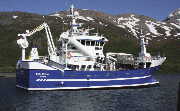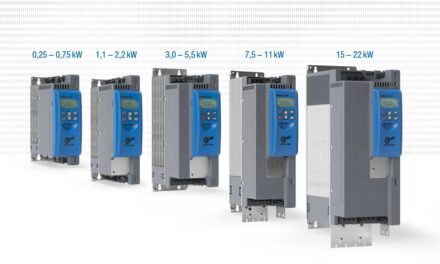 Variable speed drives from Danfoss have been used throughout the MV Fugløyhav to ensure the fishing boat’s catch arrives home as fresh as the day it was caught.
Variable speed drives from Danfoss have been used throughout the MV Fugløyhav to ensure the fishing boat’s catch arrives home as fresh as the day it was caught.
Today’s modern fishing boats are very high-tech pieces of equipment, designed to efficiently bring the catch home in prime condition to ensure the best price. MV Fugløyhav, built at Vaagland’s yard in Norway, is a typical example.
Despite measuring just 34m long and displacing 499 tonnes, this fishing boat features the latest technology, including drives from Danfoss. In fact, variable speed control of the hydraulic pumps that control the main steering gear, the refrigeration system which keeps the catch alive and fresh, and the thrusters that position the ship when bringing the valuable catch onboard, are all handled by Danfoss VLT AutomationDrives.
Propulsion
The main propulsion unit driving the propeller is a diesel engine with a shaft generator supported by an auxiliary diesel generator set. Between them, there are two generators providing the total electrical power throughout the boat, and particularly the many VLT drives that control the steering, thrusters and refrigeration plant.
Daniel Kvalvik of Elmarin, the contractor in charge of the thruster application, as well as all the electric installation on board, explained that the Danfoss VLT AutomationDrive series was used for the stern and bow thruster. Of benefit here, the drives were easy to program, due to their intuitive and user-friendly Local Control Panel. Furthermore, the soft-start characteristic of drive motor control is critical on marine applications as this limits the peak loading on the diesel generators. This means that smaller generator sets can be provisioned, a major benefit as there are always space limitations onboard small vessels.
Precision rudder positioning
The Fugløyhav’s rudder is positioned using a rotary vane hydraulic steering unit. The dual-redundant reversible hydraulic pumps are each controlled by a 22kW VLT drive, which enables precise analogue control and highly accurate rudder positioning. The rudder is only used when the boat is changing course, so no energy is used while sailing straight ahead.
Two 355kW units control the bow and stern tunnel thrusters. These provide lateral control not only when docking, but also out in the fishing fields when the boat has to manoeuvre to the net. The huge and very heavy nets are no longer lifted on board and the fish dumped on the deck – now, the boat comes alongside the net and the fish are sucked out of it alive, with minimal damage, and are pumped to refrigerated storage tanks within the boat.
A high degree of boat control is critical here, and this is provided by drive control of the tunnel thrusters. Again, the soft-start and ramp characteristics are valuable benefits of VSD control of thrusters, along with reduced energy consumption.
“Drive control of tunnel thrusters offers much superior control for coming alongside the dock or the net and is much more energy efficient than the variable pitch propeller alternative,” explained Peter Vaagland of Vaagland Båtbyggeri (Shipyard). “They require less maintenance as there’s a good deal less wear and tear and it’s a highly compact solution, especially valuable in a boat only 34m long.”
Keeping fish fresh
To allow the boat to remain at sea and still maintain the quality of the catch, the fish are kept alive in tanks of refrigerated sea water (RSW) kept at -1.5°C by a highly efficient refrigeration system. At this temperature, the fish enter a sort of suspended animation and maintain this condition for the duration of the voyage until they are unloaded live and as fresh as the day they were caught.
Fugløyhav’s refrigeration system comprises a 160kW VLT drive driven screw compressor and two 22kW VLT drive driven circulation pumps which constantly circulate the water in the holding tanks from bottom to top. Fresh sea water is added as necessary.
VLT control of the compressors and pumps enables highly accurate control of the storage conditions while saving about 20% energy compared to conventional compressor operation. The soft-start and ramp characteristics are again critical features for these systems.
Of additional benefit, the commonality of operation of the drives is a major benefit – with only one engineer on board, this will make programming and operating the drives much simpler.
Safety and reliability
Drives for marine applications have to meet stringent class specifications relating to safety and reliability. As a result, Danfoss has a high number of certifications, including Lloyds Register, DNV and six other world renowned authorities.
Danfoss


